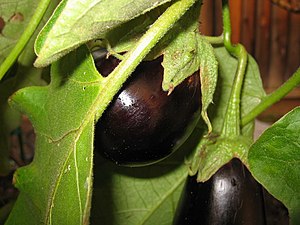What is It?
| Eggplant (Photo credit: Wikipedia) |
There are hundreds of varieties of eggplant, and while the different varieties do range slightly in taste and texture, one can generally describe the flavor as having a pleasant deep and musty taste and spongy texture. They are available in your local market year-round, but they are at their peak between August and October. Check your farmers markets for the best and freshest eggplants if you can.
History
Thomas Jefferson, who used eggplant in many of his experiments, is credited with introducing eggplant to North America. Before then, the ancient ancestors of eggplant grew wild in India and were first cultivated in China in the 5th century B.C. For centuries after its introduction into Europe, eggplant was used more as a decorative garden plant than as a food.
Although it has a long and rich history, eggplant did not always top the list of favorite veggies. Before domestication and cross-pollination, eggplant was extremely bitter and had to be cooked very well to even begin to dilute the taste. The majority of eggplant we see in stores today is grown in Florida since the weather stays mild most of the year. But New Jersey, during the summer months, is also a major supplier of fresh eggplant to produce markets. It grows pretty well throughout the United States, so you can most likely find it fresh at local farmers markets almost anywhere during the late summer months.
Health Benefits
Eggplants are extremely versatile in the kitchen and they also have several health benefits. Studies have been done on eggplant to find their deep purple skin contains an anthocyanin phytonutrient called nasunin. Nasunin is a water-soluble antioxidant (which means that it breaks down easiest when in water) and free radical scavenger that has been shown to protect cell membranes from damage. This becomes especially important in brain cell membranes which are mostly made up of lipids and are responsible for protecting the cell from free radicals and letting nutrients in and wastes out.
| Three varieties of Eggplant (Photo credit: Wikipedia) |
Another name for eggplant is Aubergine, which describes the rich purple color. You may also hear eggplant referred to as a fruit, which is accurate since that is its botanical classification. Even more confusing is eggplant is also botanically classified as a berry. And, if that's not strange enough, the seeds you see when you scoop out the inner pulp are edible, but you may not want to eat them when you hear they contain nicotinoid alkaloids. Sound familiar? Eggplant is closely related to tobacco, although the seeds are not addictive!
How to Eat
It is important to use a stainless steel knife when cutting eggplant to avoid the brown look from oxidization when using a carbon steel knife. This browning or oxidization happens fast, so only cut it when you're ready to prepare it. While eggplant can be eaten with the skin on or off, for larger fruits the peel may be tough, and it is important to “sweat” the eggplant by slicing and salting it. This will draw out some of the water and, surprisingly, a lot of the bitter taste that goes with it.
Once you have the eggplant sliced and sweated, you can add it to just about any dish you want. A classic dish of Eggplant Parmesan is always a family pleaser. A great middle eastern snack is babaganoush which is pureed roasted eggplant. Serve it with some toasted pita chips and you have one incredibly yummy snack. It also absorbs the flavors of the ingredients it is cooked with, and when cooked well it tends to disintegrate so it is a great way to incorporate extra vegetables into sauces without the kids even knowing!
If you haven't tried eggplant yet, now is the time! This time of year it is cheap and plentiful. That gorgeous color is enough to make you fall in love at first sight. But the versatility will keep you a fan for life.
Still not sure how to use this unique vegetable? Be sure to check back later this week for some tasty eggplant recipes!



No comments:
Post a Comment
We welcome comments and suggestions!